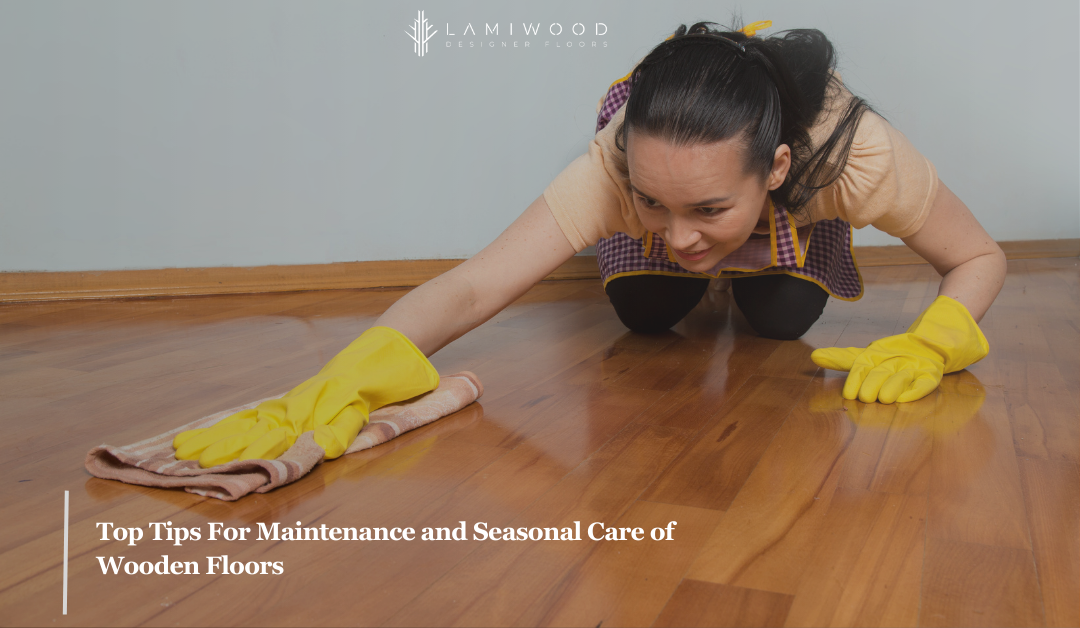Wooden flooring is known for its durability and low maintenance requirements, but it still needs to be completely maintenance-free. To keep your wooden floors looking their best and performing optimally over time, it’s important to engage in regular cleaning and care, as well as seasonal maintenance tasks that address the unique challenges of each time of year. Let’s explore the seasonal care requirements for wooden flooring, and provide tips and tricks for keeping your floors in top shape all year round.
Spring Maintenance:
- Deep Cleaning
After a long winter spent indoors, spring is the perfect time to give your wooden floors a deep cleaning. Start by thoroughly sweeping or vacuuming the floors to remove any loose dirt, dust, or debris. Then, use a damp mop or cloth to clean the surface, being careful not to oversaturate the floors. Use a mild, pH-neutral cleaning solution that is specifically designed for use on wooden flooring, and avoid harsh chemicals or abrasive scrubbers that can damage the surface.
- Check for Damage
As you’re deep cleaning your wooden floors, take the opportunity to inspect them for any signs of damage or wear. Look for scratches, dents, or gaps between the planks, and address any issues promptly to prevent further damage. If you notice any major damage or structural issues, consider contacting a professional flooring contractor for repair or replacement.
Summer Maintenance:
- Protect from Sun Damage
During the summer months, your wooden floors may be exposed to more direct sunlight than usual, which can cause fading or discoloration over time. To protect your floors from sun damage, consider installing window treatments like blinds, shades, or UV-blocking film that can filter out harmful rays. You can also use area rugs or furniture to block direct sunlight in high-traffic areas.
- Control Humidity
Summer humidity can also be a challenge for wooden floors, as excess moisture in the air can cause the planks to expand and contract, leading to gaps or warping. To control humidity levels in your home, consider using a dehumidifier or air conditioner to maintain a consistent temperature and humidity level. You can also use a hygrometer to monitor humidity levels and adjust your HVAC settings accordingly.
Fall Maintenance:
- Prepare for Winter
As the weather starts to cool down in the fall, it’s important to prepare your wooden floors for the challenges of winter. Start by thoroughly cleaning your floors to remove any dirt or debris that may have accumulated over the summer. Then, consider applying a protective coating or sealant to help prevent moisture damage and wear during the winter months.
- Address Gaps and Cracks
Fall is also a good time to address any gaps or cracks that may have developed in your wooden floors over the summer. As the humidity levels drop, the planks may contract and create gaps between the boards. Use a color-matched wood filler or caulk to fill in any gaps or cracks, and sand the area smoothly to create a seamless finish.
Winter Maintenance:
- Use Doormats and Rugs
During the winter months, your wooden floors may be exposed to more moisture, salt, and debris from snow and ice. To protect your floors from damage, use doormats and area rugs at all entrances to trap dirt and moisture before it can be tracked onto the floors. Consider using a boot tray or mat to store wet shoes and boots, and encourage family members and guests to remove their footwear before entering the home.
- Maintain Consistent Temperature
Winter temperature fluctuations can also be a challenge for wooden floors, as the planks may expand and contract with changes in humidity and temperature. To maintain a consistent temperature in your home, consider using a programmable thermostat that can automatically adjust the temperature based on your schedule and preferences. Avoid placing laminate flooring too close to heat sources like radiators or fireplaces, as this can cause the planks to dry out and crack over time.
Year-Round Maintenance Tips:
- Sweep or Vacuum Regularly
Regardless of the season, it’s important to sweep or vacuum your wooden floors regularly to remove dirt, dust, and debris that can scratch or dull the surface over time. Use a soft-bristled broom or a vacuum with a soft brush attachment to avoid damaging the surface.
- Clean Up Spills Promptly
Accidents happen, but it’s important to clean up spills and messes on your wooden floors promptly to prevent staining or damage. Use a damp cloth or paper towel to blot the spill, being careful not to rub or scrub the surface. For tougher stains, use a mild cleaning solution and a soft cloth to gently remove the stain.
- Avoid Harsh Chemicals and Abrasives
When cleaning your wooden floors, it’s important to avoid harsh chemicals, abrasive scrubbers, or steam cleaners that can damage the surface of the protective coating. Stick to mild, pH-neutral cleaning solutions that are specifically designed for use on wooden flooring, and always follow the manufacturer’s instructions for use.
- Use Furniture Pads and Protectors
Use furniture pads and protectors on the feet of all furniture and appliances to prevent scratches, dents, and other damage to your wooden floors. Consider using area rugs or runners in high-traffic areas to provide additional protection and cushioning.
Conclusion
Seasonal maintenance is an important part of keeping your wooden floors looking and performing their best over time. By following these tips and tricks for spring, summer, fall, and winter maintenance, as well as year-round care and cleaning, you can ensure that your wooden floors remain beautiful, durable, and functional for years to come. Whether you’re dealing with sun damage, humidity, or winter weather, a little bit of regular care and attention can go a long way in protecting your investment and enhancing the overall look and feel of your home. So don’t neglect your wooden floors – give them the seasonal TLC they deserve and enjoy the benefits of a well-maintained and beautiful flooring surface.

